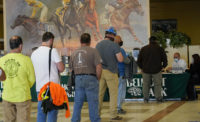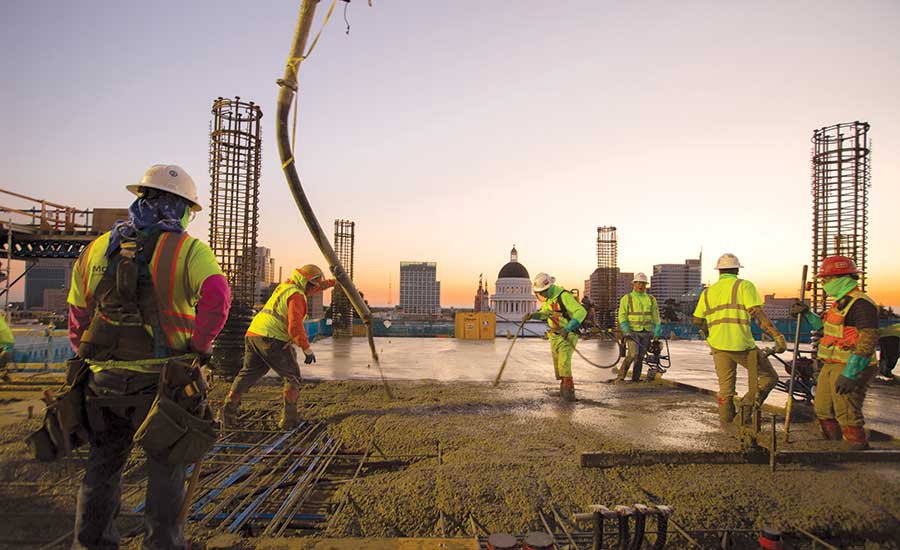ENR 2020 Top 25 Newsmakers
A Resilient Workforce Triumphs Through a Tough 2020

At 5 a.m. on a very hot summer day in Sacramento last year, a socially distanced Hensel Phelps construction team had been pouring concrete for three hours on a state government building project. Project life under COVID-19 protocols had many challenges for industry participants.
PHOTO BY MICHAEL O’CALLAHAN

Emily Sullivan, a Clark Construction purchasing director, does her job remotely at home in San Mateo, Calif., while her son Edric, 6, attends virtual first grade at the dining room table that he shares with project blueprints belonging to dad, Adam, a Clark Construction executive.
PHOTO COURTESY EMILY SULLIVAN


For the global construction workforce, 2020 was a year like no other.
The COVID-19 pandemic upended daily work life in ways many had never experienced, ranging from distanced jobsite crews and no-contact education and training to shifts, halts and cancellations of long-scheduled projects and managing job details, staff, and clients with little or no face-to-face interaction.
Strategies had to be reassessed for growth, or even survival, in a much-changed present and still-uncertain future.
Current and future construction participants innovated ways to get the job done., and after 10 months of pandemic, the resilience of the industry’s workforce is clear in how they met the challenges. Virus protocols and remote interactions now are standard operating procedure in construction, but adapting to the new normal added another dimension to project and career pressures.
Part of Your Day
Jerry Strehle, a veteran union ironworker with Local 46 in the New York City metro area, takes new health and safety measures in stride. “Now you know you have to get to work 10 minutes early and get your temperature checked. You have to have your mask. You have to wash your hands. It just becomes part of your day.”
Strehle was part of a crew working on a city bridge project last March when state-imposed lockdowns began. His project continued as “essential.” Some co-workers left the job initially and some never came back, he says. As a father of five, including three in college, “I had no choice,” he says. On site, he wears two masks every day and makes sure everyone around him follows the same rules.
“You can’t come onsite until you face me,” says Andre Curtis, a 29-year union laborer with local 202R who is the first line of defense on a jobsite just outside Washington, D.C. “And to face me, you have to have your hard hat, your vest, your glasses and your mask.” Working traffic control, part of his job is to make sure anyone entering the site follows safety protocols, he says, adding that the adjustment was easier because he has always been part of a strong safety culture.
Even with precautions in the UK, London builders now are under government pressure to cut worker overcrowding in travel on public transportation, to jobsites, or face projectss being shut down, with about 40 contractor CEOs holding an emergency “summit” with officials last month to develop solutions..
The new virus risk was potent for workers. “That you stay home when sick is not something that tradespeople in general had done prior to COVID-19,” says Osha Ashworth, business representative for an electrical workers local in San Francisco. “Knowing I could potentially spread a deadly virus has really had me focus on taking every precaution,” she says. “Maybe the silver lining will be better habits after the pandemic is over.”
Silver Linings
Another pandemic silver lining is technological efficiency. Rusty Roten, president of a greater Los Angeles’ electrical workers’ local, says regulations forced the union to close its ever-busy dispatch rooms, where daily jobs post to a monitor. Another local moved to broadcast jobs that workers could access remotely via the Zoom app. “We would never have done this,” says Roten, noting the extra expense. “Technical change was forced on us, and it was a good thing.”
Steve Rank, operating engineers’ union executive director of safety, notes joint labot-contractor safety efforts on the $1-billion Kansas City, Mo., airport project that include use of proximity devices for workers to enable contact tracing of all employees. But despite hassles of added mandates, “In some cases, projects are tracking ahead of schedule,” he says.
On an upgrade of a critical natural gas distribution station in Illinois, socially distanced crews worked three shifts, seven days a week, to get the job completed by its August deadline, says Matt Bivins, project manager and estimator for contractor Meade. “We felt like even as COVID did impact the project, we would be able to roll with it, and it worked out well,” he says.
“Having extra protocols in place for Covid-19 turned into a near ordinary response to situations construction workers face daily,” says Greg Lalevee, business manager of operating engineers’ Local 825 in New Jersey and an international union vice president. “The commitment to safety contributed to keeping work moving.”
The COVID regulations have interrupted routine inspection flow and building site access, with added challenges of enforcing safety compliance, says Jamie Taylor, senior building inspector for the city of El Segundo, Calif. He adds that while inspectors are authorized to leave non-compliant sites, “if we do that, the job is held up and nobody gets paid.”
Remote Control
For many now working remotely, by order or choice, physical separation from peers has had its impacts.
A new survey of 1,000 design and construction professionals by recruitment firms Hays for UK industry publication Building, said that about 25% of respondents aised concern that childcare during the country’s first lockdown would limit career progression. The figure rises to 35% for women.
Even so, more than half thought flexible working arrangements are having a positive effect on employer organization success, with 72% welcoming the arrangements for better work-life balance
The “office” for Emily Sullivan, a Clark Construction purchasing director in San Francisco, now is her San Mateo, Calif., dining room, shared with husband, Adam, a company project executive, and their son Edric, 6, a first-grader who needs frequent reminders to stay attached to online learning modules.
With a fourth grader as well, “it is a challenge keeping them engaged, and myself in meetings,” she says. “The key I have found is planning ahead with your partner on who has what meetings, and simply trying to come to terms with not everything being perfect.”
For company chiefs, managing staff, projects and clients under COVID-19 norms pushes new buttons.
Daniel Crouch, who owns a small Los Angeles-based residential contractor, says the biggest challenge came early when the state, county and municipalities issued different safety guidelines that needed to be implemented quickly. He made the runs to Home Depot for hand sanitizer and other safety items. But fear of the virus has not deterred workers from showing up at the firm’s jobs.
“My tile guys are the ones that have been hit the hardest,” says Crouch, speaking of a six-brother subcontracting team, all of whom contracted the virus, with one fatality.
“ It’s more difficult to maintain the connection with co-workers that builds teamwork and culture, stimulates collaboration and the feeling like part of the larger company. This interaction generally leads to innovation, productivity and ultimately a better project,” says Gerald Salontai, president of engineer Hull & Associates and a veteran design firm CEO. “While staff have adapted remarkably well, the virtual environment is no substitute for normal day-to-day interaction.”
He advises managers to “check on team members routinely, plan ahead more effectively and learn how to work together via video conference. Managers will need to push best practices to keep their top performers.”
Making connections
Meanwhile, the next generation of hoped-for performers—and their teachers and mentors—are learning to cope in the current no-contact academic environment.
Despite rising concerns about potential spread of COVID-19 on campuses, Purdue University committed to in-person learning for the fall 2020 semester. “If you had asked me in August, I would have said we’d be lucky to make it to October before we had to shut down,” says Brad Benhart, an associate professor in the construction management program. “The students were very responsible. I’d be more concerned about going to WalMart than going to class.”
Eduardo Godoy, an Arizona State University CM program freshman, was concerned about the lack of direct connection to other students, faculty and industry partners when he started classes in August, and even considered leaving the field.
By November, Godoy had switched to all virtual learning. Despite the distance, he has developed peer links and is looking forward to pursuing his CM major. “I definitely do see my future,” Godoy says. “I’m a lot more confident now.”
But virus-induced stress is a fact of industry life, although Salontai says it is controllable and even beneficial. “We have a choice to succumb to the stress or adapt to it,” he says. “Many people thrive because it pushes” their limits."
Joan Zofnass, a psychologist with a private practice who also is human resources director at industry management consultant EFCG, says “social distancing alone can create an enormous amount of stress and be a major distraction from focus on work issues.”
Zofnass, who has offered advice to numerous industry participants, says “allowing people to vent a bit” through regular group interactions can help.
“It is exhausting trying to sustain optimism in a world where the news is almost always negative,” she says. “We need to acknowledge the uncertainty and move to the next phase of what we can do right now to make things more tolerable and hopefully better.”








